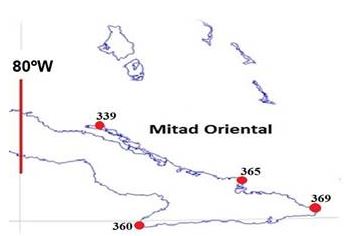Tránsito de ondas tropicales por la mitad oriental de Cuba: período 2012-2020
Contenido principal del artículo
Resumen
Las ondas tropicales son sistemas sinópticos que se presentan fundamentalmente durante los meses de mayo a noviembre, y que en ocasiones estimulan la convección profunda, y por consiguiente la ocurrencia de tormentas locales severas y/o lluvia intensa en Cuba. Estos sistemas meteorológicos son de vital importancia por su incidencia en la realización de disímiles actividades socioeconómicas, por ello que el objetivo del presente artículo es caracterizar las ondas tropicales que transitaron sobre la mitad oriental del territorio nacional desde 2012 hasta el 2020. En la investigación se revisaron las Discusiones del Tiempo Tropical y las Perspectivas del Tiempo Tropical, los estados generales del tiempo, los resúmenes mensuales, los registros de lluvias de la red pluviométrica del Instituto Nacional de Recursos Hidráulicos, mapas sinópticos e imágenes satelitales, a partir de lo cual se creó una base de datos donde se procesaron y construyeron gráficos, utilizando Office Excel versión 2019. Para el estudio se analizó la distribución de las ondas tropicales por años y meses teniendo en cuenta la velocidad de traslación de las mismas, eventos de severidad y/o lluvia intensa asociada. Los resultados evidencian que las ondas tropicales transitan todos los años por la mitad oriental, con una mayor incidencia de ondas “normales” y “activas” entre los meses de julio y agosto, lo que coincide con el período lluvioso. Por otra parte, se encontró que los eventos que más predominan son los granizos y la aeroavalanchas.
Descargas
Detalles del artículo

Esta obra está bajo licencia internacional Creative Commons Reconocimiento-NoComercial 4.0.
Aquellos autores/as que tengan publicaciones con esta revista, aceptan los términos siguientes de la Licencia CC Reconocimiento-NoComercial 4.0 Internacional (CC BY-NC 4.0):
Usted es libre de:
- Compartir — copiar y redistribuir el material en cualquier medio o formato
- Adaptar — remezclar, transformar y crear a partir del material
El licenciador no puede revocar estas libertades mientras cumpla con los términos de la licencia.
Bajo las condiciones siguientes:
- Reconocimiento — Debe reconocer adecuadamente la autoría, proporcionar un enlace a la licencia e indicar si se han realizado cambios. Puede hacerlo de cualquier manera razonable, pero no de una manera que sugiera que tiene el apoyo del licenciador o lo recibe por el uso que hace.
- NoComercial — No puede utilizar el material para una finalidad comercial.
- No hay restricciones adicionales — No puede aplicar términos legales o medidas tecnológicas que legalmente restrinjan realizar aquello que la licencia permite.
La revista no se responsabiliza con las opiniones y conceptos emitidos en los trabajos, son de exclusiva responsabilidad de los autores. El Editor, con la asistencia del Comité de Editorial, se reserva el derecho de sugerir o solicitar modificaciones aconsejables o necesarias. Son aceptados para publicar trabajos científico originales, resultados de investigaciones de interés que no hayan sido publicados ni enviados a otra revista para ese mismo fin.
La mención de marcas comerciales de equipos, instrumentos o materiales específicos obedece a propósitos de identificación, no existiendo ningún compromiso promocional con relación a los mismos, ni por los autores ni por el editor.
Citas
Añón, O. (2012). Comportamiento de las ondas tropicales que afectaron a Cuba en el período 2003-2011. [Tesis de Licenciatura] Instituto Superior de Tecnología y Ciencias Aplicadas. La Habana.
Ávila, L., & Clark, G. (1989). Atlantic Tropical Systems of 1988. Monthly Weather Review, 117, 2260-2265.
Ávila, L., & Pasch, R. (1995). Atlantic Tropical Systems of 1993. Monthly Weather Review, 123, 2887-2896.
Ávila, L., Pasch, R., & Jiing, J. (2000). Atlantic Tropical Systems of 1996 and 1997: Years of Contrasts. Monthly Weather Review, 128, 3695-3706.
Burpee, R. W. (1972). The origin and structure of easterly waves in the lower troposphere of North Africa. Journal of the Atmospheric Sciences, 29, 77-90.
Instituto de Meteorología de Cuba. (2017). Manual de Procedimientos Operacionales Ordinarios. Cuba.
Landsea, C. W. (1993). A climatology of intense (or major) Atlantic Hurricanes. Monthly Weather Review, 121, 1703-1713.
Leary, C. A. (1984). Precipitation structure of the could clusters in a tropical Easterly Wave. Monthly Weather Review, 112, 313-325.
Sosa, M. (1994). Climatología y pronóstico de las ondas tropicales en Cuba [Tesis de Doctorado] Instituto de Meteorología. Ciudad de La Habana.
Varela, A. & Carnesoltas, M. (2017). Condiciones que favorecen el desarrollo de tornados en las provincias occidentales de Cuba en los períodos lluvioso y poco lluvioso. Revista Cubana de Meteorología, 23 (3), 12-327, ISSN: 0864-151X.
Varela, A., Rojas, Y. & Carnesoltas, M. (2022). Caracterización de los reportes de tormentas locales severas en Cuba entre 1980-2020. Revista Cubana de Meteorología, 28 (2). ISSN: 2664-0880. https://cuid.com/2377/v28n2e05.

